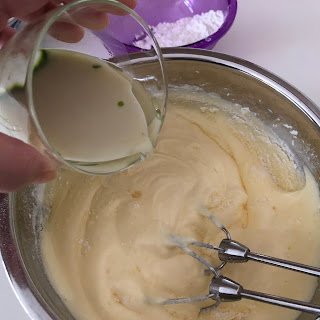A simple steamed cake with low-sugar kaya sandwiched in between layers. Suitable as a light night snack to enjoy before sleep 😴🛌 Although it is not a healthy habits to eat before sleep, I can't sleep with an empty stomach too 😌
Yield: 1 x 13cm round cake
Pan size: 14 x 5 cm round cake pan
I bought this small cake pan from Daiso
Ingredients
All ingredients in room temperatureUsing 55g Omega 3&6 eggs
53g water
5g pandan leaf
5g pandan leaf
10g condensed milk
10g coconut oil
10g coconut oil
2 egg whites
Pinch of salt
50g fine sugar
2 egg yolks
Pinch of salt
50g fine sugar
2 egg yolks
70g top/cake flour
Filling
40g kaya jam, less-sugar version
5g hot water
5g hot water
Directions
1. Line a 14cm round cake mould with parchment paper. Set aside.Mix the pandan juice with condensed milk and coconut oil in a small glass. Set aside.
3. In a dry, clean and grease-free bowl, whisk egg whites till frothy using an electric hand mixer. Add a pinch of salt, and continue to whisk for 1/2 minute.
Slowly whisk in the sugar in three additions.
Whisk till firm peak stage.
Whisk in the egg yolks, one at a time.
Continue to whisk till reaching ribbon stage (the dripped beaten egg stays on the surface for more than 10 seconds).
4. Mix in the sieved top flour and pandan-milk mixture (from Step 2), in alternating sequence. Start with flour and end with flour.
Flour ⏩ pandan-milk ⏩ flour ⏩ pandan-milk ⏩ flour
Use a spatula to give the batter a thorough mix. Ensure no liquid settle at the bottom of the mixing bowl.
5. Pour the batter into the lined cake pan.
Bang lightly to remove any trapped air bubbles.
6. Pour about 100g of water into an 18cm pot and bring to a light boil at medium-low heat. Place a shallow steamer's stand in it.
Lower the cake pan into the pot, cover with a glass lid, and let it steam at medium-low heat for about 5 minutes. The glass-lid has a steam-vent to prevent pressure building up.
5 minutes later, lower the heating to low, and continue to steam for 15 minutes.
15 minutes later
Remove the lid carefully to avoid the condensed water from dripping onto the surface of the cake.
Check the cake with a cake tester to ensure it is thoroughly cooked.
7. Lift the cake pan out of the pot, and drop it thrice to a kitchen towel from a height of about 10 cm. This is to prevent the cake from excessive shrinking after cooling down.
Let the cake cool down in the pan for about 5 minutes before removing the pan.
Let the cake cool down completely over a wire rack.
8. Mix 40g of less-sugar kaya jam with about 1 tsp of hot water. This is to make the kaya easier to apply over the cake. If your kaya has a low consistency, you can omit the hot water.
9. Pull down the parchment paper and trim away excess paper.
Divide the cake into three layers.
Apply kaya jam over the cake face and stack back the cake layers.
10. Let the cake rest for 5 to 20 minutes before cutting it.
Enjoy it at room temperature or cold. Keep the unfinished cake in the fridge 😋





























































